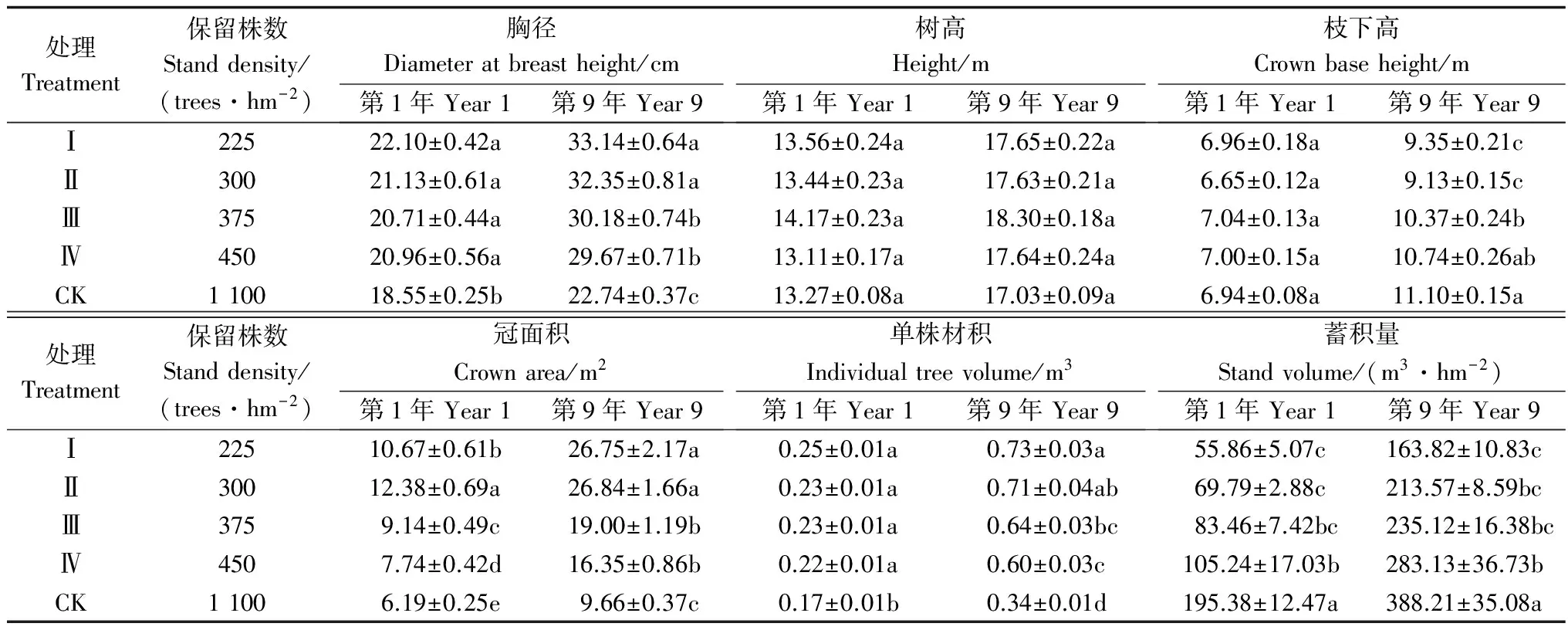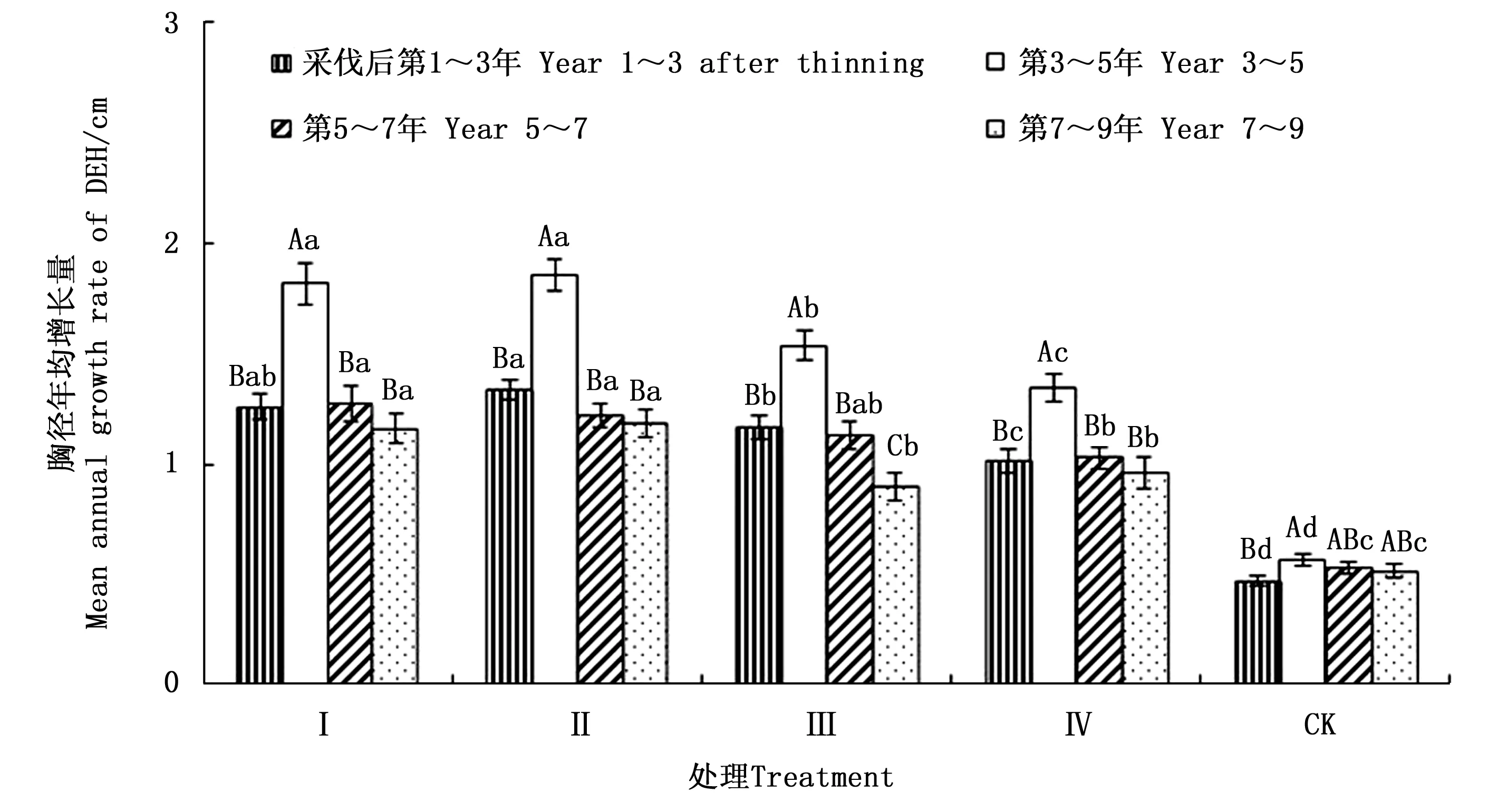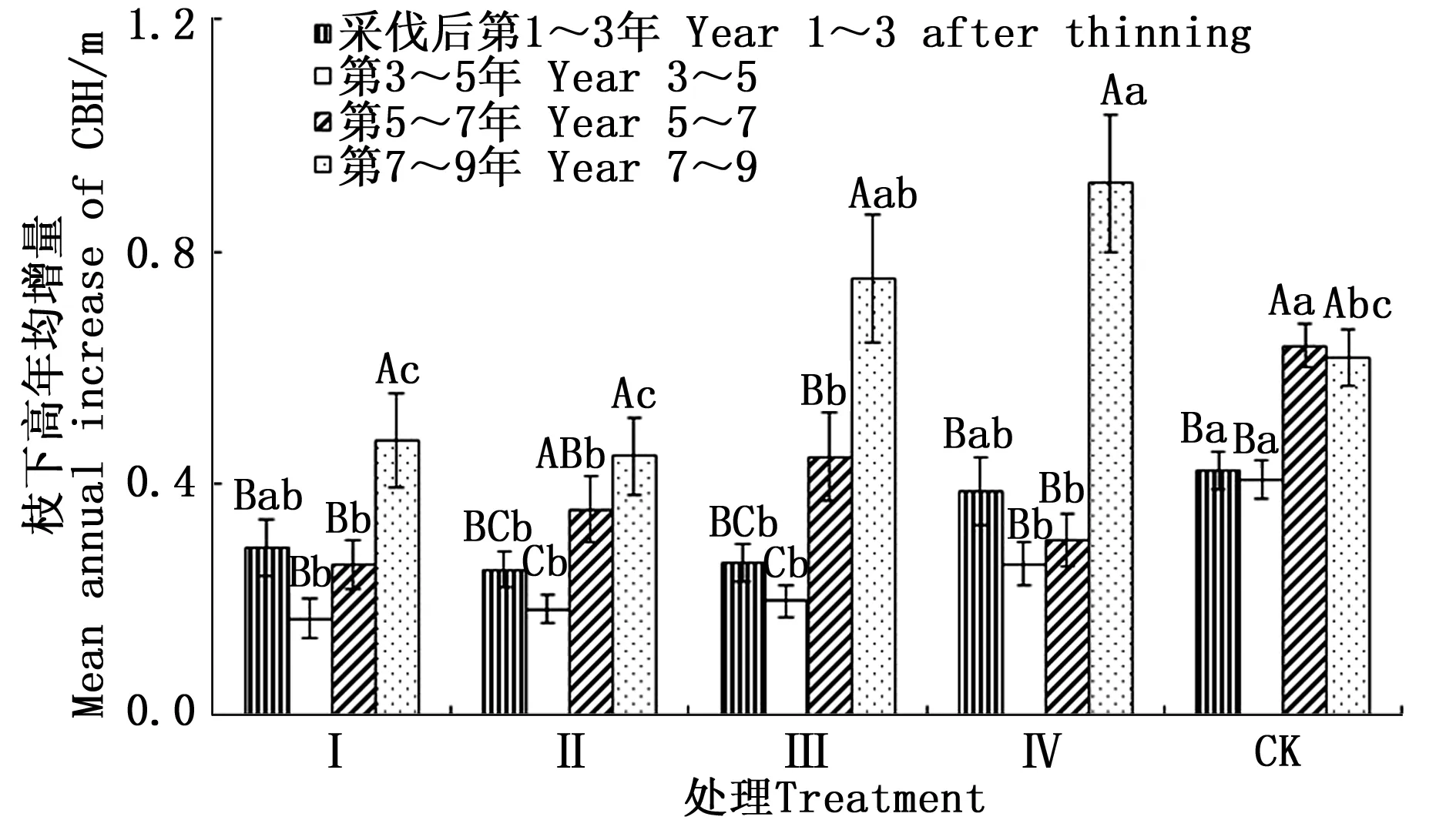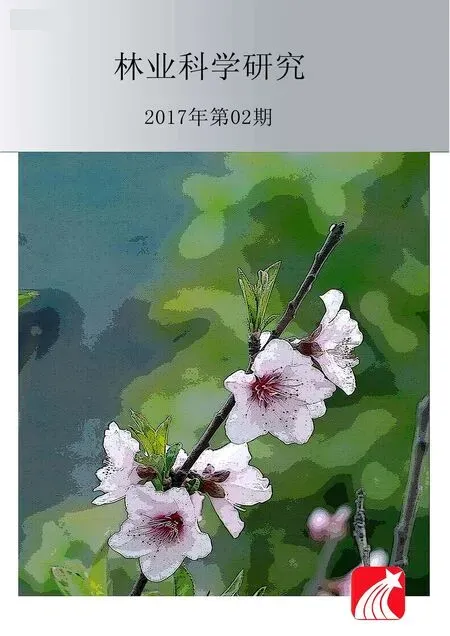桂西南马尾松人工林生长对不同强度采伐的动态响应*
曾 冀,雷渊才,贾宏炎,蔡道雄,唐继新
(1.中国林业科学研究院热带林业实验中心,广西 凭祥 532600; 2. 中国林业科学研究院资源信息研究所,北京 100091)
桂西南马尾松人工林生长对不同强度采伐的动态响应*
曾 冀1,2,雷渊才2**,贾宏炎1,蔡道雄1,唐继新1
(1.中国林业科学研究院热带林业实验中心,广西 凭祥 532600; 2. 中国林业科学研究院资源信息研究所,北京 100091)

马尾松;强度采伐;密度效应;生长动态
马尾松(PinusmassonianaLamb.) 是我国南方亚热带地区分布最广、资源最多的松类树种,不仅具有很高的经济价值,而且在森林生态系统恢复和重建中发挥着重要作用[1]。桂西南地区热量丰富、雨量充沛且雨热同季,是马尾松高产区之一;然而,由于大面积成片马尾松纯林经营,出现虫害频发、生态功能下降等问题[2]。为解决马尾松虫害问题,中国林业科学研究院热带林业实验中心(以下简称热林中心) 自2005年以来,陆续开展了马尾松人工林近自然化改造的探索,方法是选择适宜的采伐强度,在林下套种乡土阔叶树进行马尾松人工纯林近自然化改造,促进其向马尾松-阔叶异龄林的转变,并加快马尾松大径材培育速度。本研究于2007年,对热林中心14年生马尾松人工林开始进行近自然化改造的不同强度采伐试验,定期开展生长观测,以期揭示不同强度采伐下马尾松林分的生长动态,为完善马尾松人工林近自然经营提供参考。
早在19世纪,瑞士和斯洛文尼亚即开展近自然森林经营研究,Schütz[3]研究了近自然化改造100年后的欧洲橡树林,发现近自然森林经营能很好地解决采伐和天然更新等经营问题。Ward[4]对北美红栎(QuercusrubraL.) 及Miller[5]对北美红栎 、山栎(QuercusprinusL.) 、美国黑樱桃(PrunusserotinaEhrh.)和黄杨木(LiriodendrontulipiferaL.)的研究均表明,采伐能促进幼龄林的胸径生长。Smith等[6]对北美红栎及Stringer等[7]对白栎(QuercusfabriHance)的研究发现,强度采伐亦能促进成熟林的胸径生长。Trimble[8]对黄杨木和美国黑樱桃及Lamson等[9]对加拿大糖槭(AcernegundoLinn.)的一些研究认为,采伐会减缓树高生长;Smith等[10]的研究则认为,采伐对美国黑樱桃、加拿大糖槭的树高生长基本无影响,但对黄杨木的树高生长具促进作用。相对于常规间伐,近自然经营中的采伐强度更大,主要针对林分中的目标树进行单株管理,使目标树在较短的时间内达到目标胸径[11]。从国内有关近自然经营采伐的研究报道可看出,大部分是关于采伐后的林下物种多样性[12]、森林更新[13]和目标树生长[14]等研究,而关于林木生长对采伐的动态响应研究较少,仅李婷婷等[15]研究了杉木人工林近自然化改造后的林分生长,比较了47%和61%两个强度采伐后4年内林分蓄积生长量和单木生长量等动态变化。尽管目前已有一些关于马尾松、杉木间伐方面的研究[16-18],而对不同强度采伐后的马尾松生长动态鲜有报道。为此,本文利用马尾松近自然改造试验林,以系统研究马尾松生长指标与采伐强度间的相关性,为马尾松人工林近自然化改造工作提供依据和指导。
1 试验地概况

1993年,在热林中心伏波实验场用种源为宁明桐棉的1年生裸根苗营造马尾松人工纯林,株行距为2.0 m×2.5 m,初植密度为2 000株·hm-2,于1999年和2003年分别进行了强度约20%的透光伐和强度约30%的抚育性间伐。
2 研究方法
2.1 试验设计


表1 样地概况
注:Ⅰ、Ⅱ、Ⅲ和Ⅳ表示处理,其采伐强度分别为80%、73%、66%和59%;下标为区组编号。
Notes: Ⅰ, Ⅱ, Ⅲ and Ⅳ refer to thinning treatments, and their intensities are 80%, 73%, 66% and 59%, respectively; and their subscripts are codes of blocks in the experiment.
2.2 生长观测
采伐作业前,在马尾松纯林内设置3块400 m2的圆形样地进行本底调查,调查样地内所有马尾松植株的胸径、树高、枝下高和冠幅。应用围尺进行每木检尺,采用皮尺分东、西、南、北4个方向测定冠幅,VERTEX超声波测高器测量树高和枝下高。林分平均保留密度为1 100株·hm-2,平均胸径18.26 cm,平均树高11.64 m,平均蓄积量150.25 m3·hm-2。采伐后,在每个小区中心位置附近选取一个圆心点布设半径为11.3 m、面积400 m2的圆形样地,分别于2008、2010、2012、2014年底和2016年8月对所有保留木进行生长观测。
2.3 数据处理
冠面积为东西、南北2个方向冠幅的乘积。
单株材积(V):V=g×f×h
式中:h为全树高(m);g为胸高断面积(m2);f为平均实验形数,马尾松取0.39[19]。
采用单因素方差分析和Duncan多重比较检验不同采伐强度下马尾松林分的胸径、树高、单株材积和蓄积年均增长量及枝下高、冠面积年均变化量,应用SPSS16.0 软件进行数据统计分析。由于套种的植株尚未进入主林层,对马尾松生长的影响较小,故本研究在分析生长动态时未予考虑。
3 结果与分析
3.1 胸径生长动态


表2 采伐后第1年和第9年马尾松林分的生长表现
注:表中字母为Duncan多重比较结果,处理间具相同字母表示差异不显著(P≥0.05), 不同字母表示差异显著(P<0.05)。
Note: Values followed by the same letters in a column are not significantly different among treatments at 0.05 level according to Duncan’s multiple range tests.

图1 不同采伐强度马尾松人工林胸径年均增长量(大写字母表示同一采伐强度处理年际间差异;小写字母表示同一年份采伐强度处理间的差异。具相同字母表示差异不显著(P≥0.05);不同字母表示差异显著(P<0.05),下同。)
Fig.1 Mean annual growth rate of diameter at breast height(DBH) in Pinus massoniana plantations after thinning with different intensities (Colum values with the same lowercase and capital letters are not significantly different among years after thinning with each intensity and among thinning treatments in each year according to Duncan’s multiple range tests at the 5% level. The same below.)
3.2 树高生长动态


图2 不同采伐强度马尾松人工林树高年均增长量
Fig. 2 Mean annual growth rate of height in Pinus massoniana plantations after thinning with different intensities
3.3 枝下高动态变化


图3 不同采伐强度马尾松人工林枝下高年均增长量
Fig.3 Mean annual increase of crown base height (CBH) in Pinus massoniana plantations after thinning with different intensities
3.4 冠面积动态变化



图4 不同采伐强度马尾松人工林冠面积年均增长量
Fig.4 Mean annual growth rate of crown area (CA) in Pinus massoniana plantations after thinning with different intensities
3.5 单株材积生长动态


图5 不同采伐强度马尾松人工林单株材积年均增长量
Fig.5 Mean annual growth rate of individual tree volume (ITV) in Pinus massoniana plantations after thinning with different intensities
3.6 马尾松林分蓄积动态变化


图6 不同采伐强度马尾松人工林蓄积年均增长量
Fig.6 Mean annual growth rate of stand volume (SV) in Pinus massoniana plantations after thinning with different intensities
4 讨论


林下套种阔叶树对保留木生长存在一定的影响,但本研究未考虑其对上层林木的影响;然而,随着时间的推移可能逐渐出现套种林木与马尾松的水肥竞争。另一方面,阔叶树的凋落物分解快,可以加速林地的养分循环,从而对林下物种多样性、土壤等亦会产生积极影响。不同强度采伐后,林分的恢复是一个长期的过程,采伐强度越大,则影响的持续时间越长[31]。总而言之,本研究只是采伐后马尾松生长动态研究的阶段性总结,未来阔叶树逐渐进入主林层,马尾松的生长动态必然会受影响;林下植被的变化亦会影响地力,进而影响林分生产力[32-34],有待长期观测研究。
5 结论

[1] 雷 蕾, 肖文发, 曾立雄, 等. 不同营林措施对马尾松林土壤呼吸影响[J]. 林业科学研究, 2015, 28(5): 713-719.
[2] 马归燕. 马尾松天然林病虫害调查[J]. 中国森林病虫, 2001, 20(2): 40-41.
[3] Schütz J P. Close-to-nature silviculture: is this concept compatible with species diversity? [J]. Forestry, 1999, 72(4): 359-366.
[4] Ward J S. Crop-tree release increase growth of red oak saw timber: 12 year results[C]. Proceedings 16th Central Hardwood Forest Conference, 2008:457-465.
[5] Miller G W. Effect of crown growing space on the development of young hardwood crop trees[J]. Northern Journal of Applied Forestry, 2000, 17(1): 25-35.
[6] Smith H C, Miller G W. Releasing 75-to 80-year-old Appalachian hardwood saw timber trees: 5-year DBH response[C]. Proceedings of the 8th Central Hardwood Forest Conference, 1991:403-413.
[7] Stringer J W, Miller G W, Wittwer R F. Applying a crop-tree release in small-saw timber white oak stands[R]. Research Paper-Northeastern Forest Experiment Station, USDA Forest Service NE-620, 1988.
[8] Trimble G R. Response to crop tree release by 7-year-old stems of yellow-poplar and black cherry[R]. Research Paper-Northeastern Forest Experiment Station, USDA Forest Service NE-303, 1973.
[9] Lamson N I, Smith H C. Response to crop-tree release: sugar maple, red oak, black cherry, and yellow-poplar saplings in a 9-year-old stand[R]. Research Paper -Northeastern Forest Experiment Station, USDA Forest Service NE-394, 1978.
[10] Smith H C, Lamson N I. Precommercial crop-tree release increases diameter growth of Appalachian hardwood sapling[R]. Research Paper - Northeastern Forest Experiment Station, USDA Forest Service NE-534, 1983.
[11] 陆元昌. 近自然森林经营理论与实践[M]. 北京: 科学出版社,2006.
[12] 马履一, 李春义, 王希群, 等. 不同强度间伐对北京山区油松生长及其林下植物多样性的影响[J]. 林业科学, 2007, 43(5): 1-9.[13] 李 荣, 何景峰, 张文辉, 等. 近自然经营间伐对辽东栎林植物组成及林木更新的影响[J]. 西北农林科技大学学报:自然科学版, 2011, 39(7): 83-91.
[14] 王懿祥, 张守攻, 陆元昌, 等. 干扰树间伐对马尾松人工林目标树生长的初期效应[J]. 林业科学, 2014, 50(10): 67-73.
[15] 李婷婷, 陆元昌, 庞丽峰, 等. 杉木人工林近自然经营的初步效果[J]. 林业科学, 2014, 50(5): 90-100.
[16] 盛炜彤. 不同密度杉木人工林林下植被发育与演替的定位研究[J]. 林业科学研究, 2001, 14(5): 463-471.
[17] Miller G W, Stringer J K. Effect of crown release on tree grade and DBH growth of white oak sawtimber in eastern Kentucky[C]. Proceedings of the 14th Central Hardwood Forest Conference, 2004: 27-44.
[18] 徐金良, 毛玉明, 郑成忠, 等. 抚育间伐对杉木人工林生长及出材量的影响[J]. 林业科学研究, 2014, 27(1): 99-107.
[19] 孟宪宇. 测树学(第二版) [M]. 北京:中国林业出版社,1996.
[20] Zhang J, Oliver W W, Powers R F. Long-term effects of thinning and fertilization on growth of red fir in northeastern California[J]. Canadian Journal of Forest Research, 2005, 35(6): 1285-1293.
[21] O’Hara K L, Nesmith J C B, Leonard L,etal. Restoration of old forest features in coast redwood forests using early-stage variable-density thinning[J]. Restoration Ecology, 2010, 18(s1): 125-135.[22] Condés S, Sterba H. Derivation of compatible crown width equations for some important tree species of Spain[J]. Forest Ecology & Management, 2005, 217(2): 203-218.
[23] Russell M B, Weiskittel A R. Maximum and largest crown width equations for 15 tree species in Maine[J]. Northern Journal of Applied Forestry, 2011, 28(2): 84-91.
[24] 公宁宁, 马履一, 贾黎明, 等. 不同密度和立地条件对北京山区油松人工林树冠的影响[J]. 东北林业大学学报, 2010, 38(5): 9-12.
[25] 符利勇, 孙 华. 基于混合效应模型的杉木单木冠幅预测模型[J]. 林业科学, 2013, 49(8): 65-74.
[26] Medhurst J L, Beadle C L, Neilsen W A. Early-age and later-age thinning affects growth, dominance, and intraspecific competition inEucalyptusnitensplantations[J]. Canadian Journal of Forest Research, 2001, 31(2): 187-197.
[27] 张水松, 陈长发, 吴克选, 等. 杉木林间伐强度试验20年生长效应的研究[J]. 林业科学, 2005, 41(5): 56-65.
[28] 谌红辉, 方升佐, 丁贵杰, 等. 马尾松间伐的密度效应[J]. 林业科学, 2010, 46(5): 84-91.
[29] 孟京辉, 陆元昌, 王懿祥, 等. 海南岛热带天然次生林生长动态研究[J]. 林业科学研究, 2010, 23(1): 77-82.
[30] 蔡道雄, 贾宏炎, 卢立华, 等. 我国南亚热带珍优乡土阔叶树种大径材人工林的培育[J]. 林业科学研究, 2007, 20(2): 165-169.
[31] Misson L, Vincke C, Devillez F. Frequency responses of radial growth series after different thinning intensities in Norway spruce (Piceaabies(L.) Karst.) stands[J]. Forest Ecology and Management, 2003, 177(1-3): 51-63.
[32] 盛炜彤. 杉木林的密度管理与长期生产力研究[J]. 林业科学, 2001, 37(5): 2-9.
[33] 雷相东, 陆元昌, 张会儒, 等. 抚育间伐对落叶松云冷杉混交林的影响[J]. 林业科学, 2005, 41(4): 78-85.
[34] 熊有强, 盛炜彤. 不同间伐强度杉木林下植被发育及生物量研究[J]. 林业科学研究, 1995,8(4): 408-412.
(责任编辑:徐玉秀)
Dynamic Growth Response ofPinusMassonianaPlantation on Intensive Thinning in Southwestern Guangxi, China
ZENGJi1,2,LEIYuan-cai2,JIAHong-yan1,CAIDao-xiong1,TANGJi-xin1
(1. Tropical Forestry Research Center , Chinese Academy of Forestry, Pingxiang 532600, Guangxi,Chian; 2. Research Institute of Forest Resources Information Techniques, Chinese Academy of Forestry, Beijing 100091,Chian)
[Objective]Growth dynamics of Pinus massoniana were studied under intensive thinning so as to screen out suitable thinning intensity and provide technical support for close-to-nature management of Masson pine plantations. [Method] A thinning trial was conducted in a 14-year-old Masson pine plantation with stand density of 1 100 trees per hectare in October, 2007. Four thinning treatments including 225, 300, 375 and 450 trees left per hectare and the control without thinning were arranged. Since 2008, growth performance such as diameter at breast height (DBH), height, height of crown base and crown area were measured every two years, and wood volumes were calculated at the single tree and stand level. These data were analyzed through one-way variance analysis and Duncan multiple range tests to reveal dynamical responses of these index to all sorts of thinning intensities. [Result] Stand growth performance were significantly influenced by thinning intensity, mean annual increments of DBH, single tree volume, crown area decreases with increase of stand density of thinning treatments, but they were all significantly higher than those of the control (P<0.05). The crown area increments of Masson pine were the highest during year 1 to 3 after thinning, while increments of DBH were the highest during year 3 to 5. No obvious relationship was observed between tree height growth rate and thinning density. Increases of crown base height and stand volume were significantly affected by stand density, and they increased with increase of stand density, while the differences of stand volume decreased with increase of forest age. [Conclusion] In the present study, Masson pine’s response of crown growth to intensive thinning was the most sensitive and rapid. The crown area increased sharply at first, then resulted in rapid growth of DBH, while tree height and crown base height increased a bit stably. Thinning with four intensities all remarkably influenced the growth of single tree volume, but only thinning with 225 trees left per hectare had significant effect on increment of stand volume. Taking mean annual increments of the single tree volume and stand volume, thinning intensity with 300 trees left per hectare was recommended for close-to-nature management of 15-year-old Masson pine plantations in southwestern Guangxi.
Pinusmassoniana; intensive thinning; density effect; growth dynamics
2016-09-23 基金项目: 全国森林经营基础研究项目(169201531)及中国林业科学研究院热带林业实验中心主任基金(RL-2012-02) 作者简介: 曾 冀(1981—),男,四川自贡人,在读博士生,工程师,主要从事森林培育与经营研究. * 致谢:承蒙中国林业科学研究院热带林业研究所曾杰研究员审阅修改论文,特致谢忱! ** 通讯作者.
10.13275/j.cnki.lykxyj.2017.02.021
S791.248
A
1001-1498(2017)02-0335-07
——以杉木抚育间伐为例

